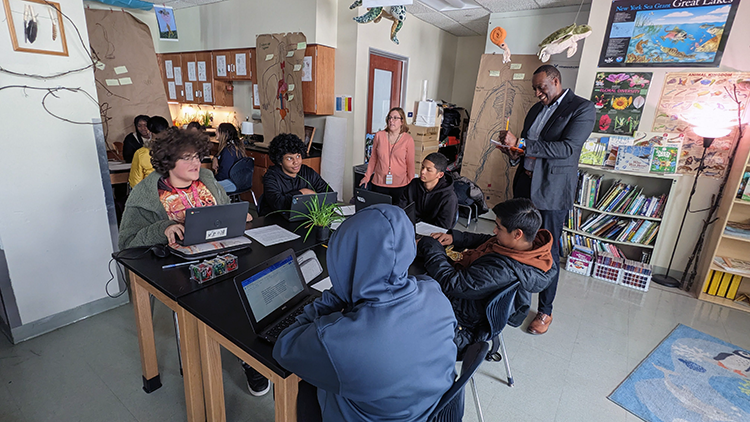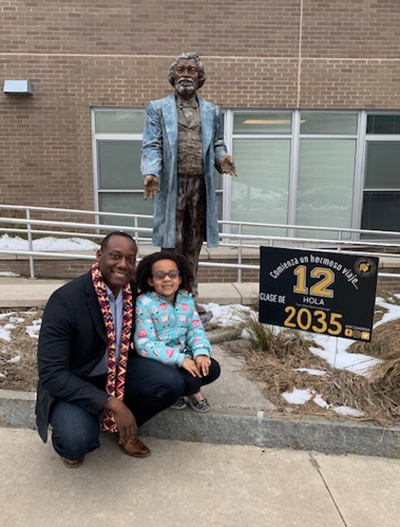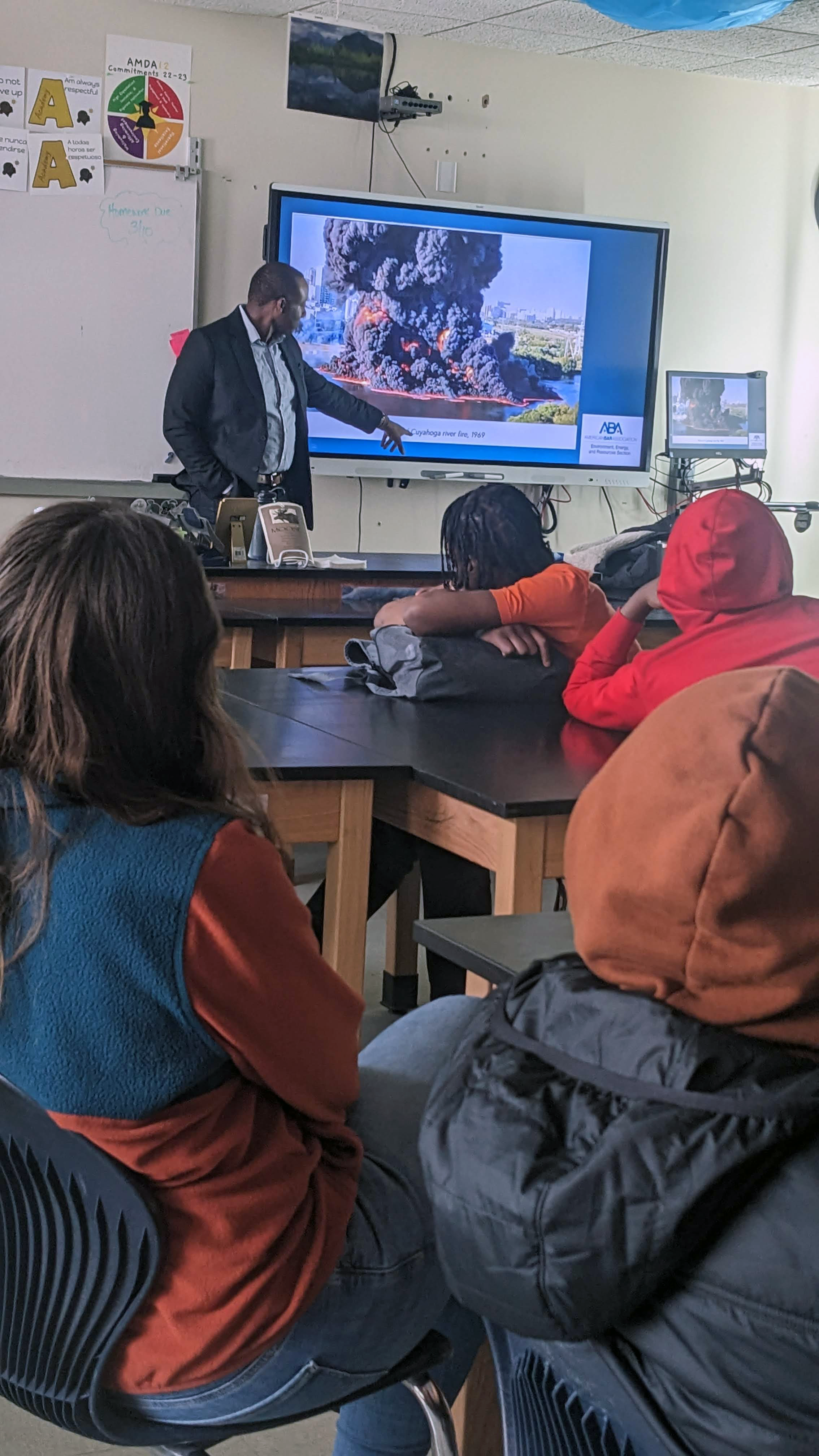Catching 'the Green Bug': Environmental law group looks to inspire middle school students

Jonathan Nwagbaraocha (top right) visited an 8th-grade class at Anna Murray-Douglass Academy School No. 12 in March to deliver a lesson about the Clean Water Act. Photo by Breanna Uckermark.
Last fall, Jonathan Nwagbaraocha discovered his daughter and other students at Anna Murray-Douglass Academy School No. 12 in Rochester, New York, were engaging in project-based learning that focuses on water.
While Grace and her kindergarten classmates explored how plants and animals in freshwater habitats use water, Nwagbaraocha learned kids in other grades focused on how to protect water sources, educate communities on the impact of erosion and conserve clean water for future generations. He was particularly interested in a task assigned to middle school students, who were conducting research on environmental justice related to water.
 Jonathan Nwagbaraocha volunteered to speak to middle school students at the school where his daughter Grace attends kindergarten.
Jonathan Nwagbaraocha volunteered to speak to middle school students at the school where his daughter Grace attends kindergarten.They had already taken water samples from Lake Ontario and captured a number of water quality standards, including the pH level. Nwagbaraocha thought a lesson on the Clean Water Act using an environmental law curriculum created by the ABA Section of Environment, Energy and Resources would complement their research and volunteered to lead the discussion.
“I think it’s important for lawyers to engage students, to let them know this is what we do, these are the issues we tackle,” says Nwagbaraocha, vice chair of SEER and environment, health, safety and sustainability counsel and compliance leader at Xerox Corp. “Whether they go to law school, whether they practice in the long term, it’s really about getting the word out that this is something they might find interesting.”
In March, Nwagbaraocha visited Kyra Stephenson’s eighth grade class, where he shared with students the history of water in the United States, the reasons for the CWA’s passage in 1972 and the scope, success and challenges of the law. Students also discussed which bodies of water were navigable water covered by the CWA and participated in a breakout session where they stepped into the role of federal government, state government, private citizens and a company to solve problems resulting from the spill of chemicals into a body of water.
 Jonathan Nwagbaraocha told the students his passion for environmental justice began when he was their age. Photo by Breanna Uckermark.
Jonathan Nwagbaraocha told the students his passion for environmental justice began when he was their age. Photo by Breanna Uckermark.“This lesson was so valuable because it was accelerated content for these kids and yet they were able to gain a deeper understanding of why we have lawyers, laws and how it connects to the environment,” Stephenson says. “It put real-life data, information and scenarios in their hands.”
Stephenson adds: “One of the best quotes for a student was, ‘I thought laws were only for criminals, I had no idea we had laws to protect water, and now I know how important our water truly is!’”
Before diving into the lesson, Nwagbaraocha says he took the opportunity to tell students he caught “the green bug” in middle school. At the time, he didn’t think about law school, but he knew he was interested in environmental justice.
“It all started with Captain Planet,” he says. “That’s what I remember watching. That was my motivation … That’s why, to me, it was like the stars aligned. They had this project, we had this curriculum, and it was the right grade level where I could share that story.”
Changing the environment
In 2020, members of SEER’s Leadership Development Program developed the curriculum, which includes five topic-specific lesson plans for middle school students. In addition to water quality, it focuses on environmental law, air quality, endangered species and waste and chemicals management.
One of the group’s objectives was to recognize the 50th anniversary of the National Environmental Policy Act, the first major environmental law in the United States. To meet that goal, members wanted to provide the curriculum to teachers and attorney volunteers to help educate students on the history of environmental protection.
Maram Salaheldin—a senior attorney at Clark Hill in Washington, D.C., who participated in the Leadership Development Program—worked on the lesson plans. She thought it was important to include links to photos and resources that show the water and air quality in major U.S. cities both before and after NEPA.
“We wanted to make sure we don’t lose track of the progress that’s been made while we are talking about the things that need to change,” she says.
The group wanted to make the lesson plans relatable to diverse students and schools, in part by focusing on environmental justice and providing profiles of young environmental activists who are making a difference, Salaheldin adds.
 After Nwagbaraocha’s presentation, the students broke into small groups to work on projects. Photo by Breanna Uckermark.
After Nwagbaraocha’s presentation, the students broke into small groups to work on projects. Photo by Breanna Uckermark.
Joshua Ash, another participant in the Leadership Development Program, also suggested creating a short video that teachers could play for students before the lessons. He worked on the video—which has been viewed more than 12,000 times on YouTube—with his partner, who is an animator.
“The video, just in general, is something that is lacking in the legal system—really accessible, broken-down summaries of different areas of law,” says Ash, an environmental protection specialist for the U.S. Department of Transportation’s Volpe Center, who lives in Pittsburgh. “We were trying to make this super easy to grasp. And for teachers, too. They have all these resources right there and ready.”
Nwagbaraocha was the first SEER member to teach the curriculum, but the section hopes others follow his lead. To celebrate Earth Day on April 22, SEER is encouraging attorneys to use the lesson plans to educate their own communities about environmental protection.
“Our goal is, and part of why we wanted to develop this curriculum, was to provide an opportunity for lawyers to go into schools, talk about environmental law and give students real-life examples of how to problem solve,” Nwagbaraocha says.
The environmental law curriculum and additional details on the project can be found on SEER’s website.
See also:
ABAJournal.com: “Pro Bone-o: Chicago animal shelter gets treats from ABA public service project”



